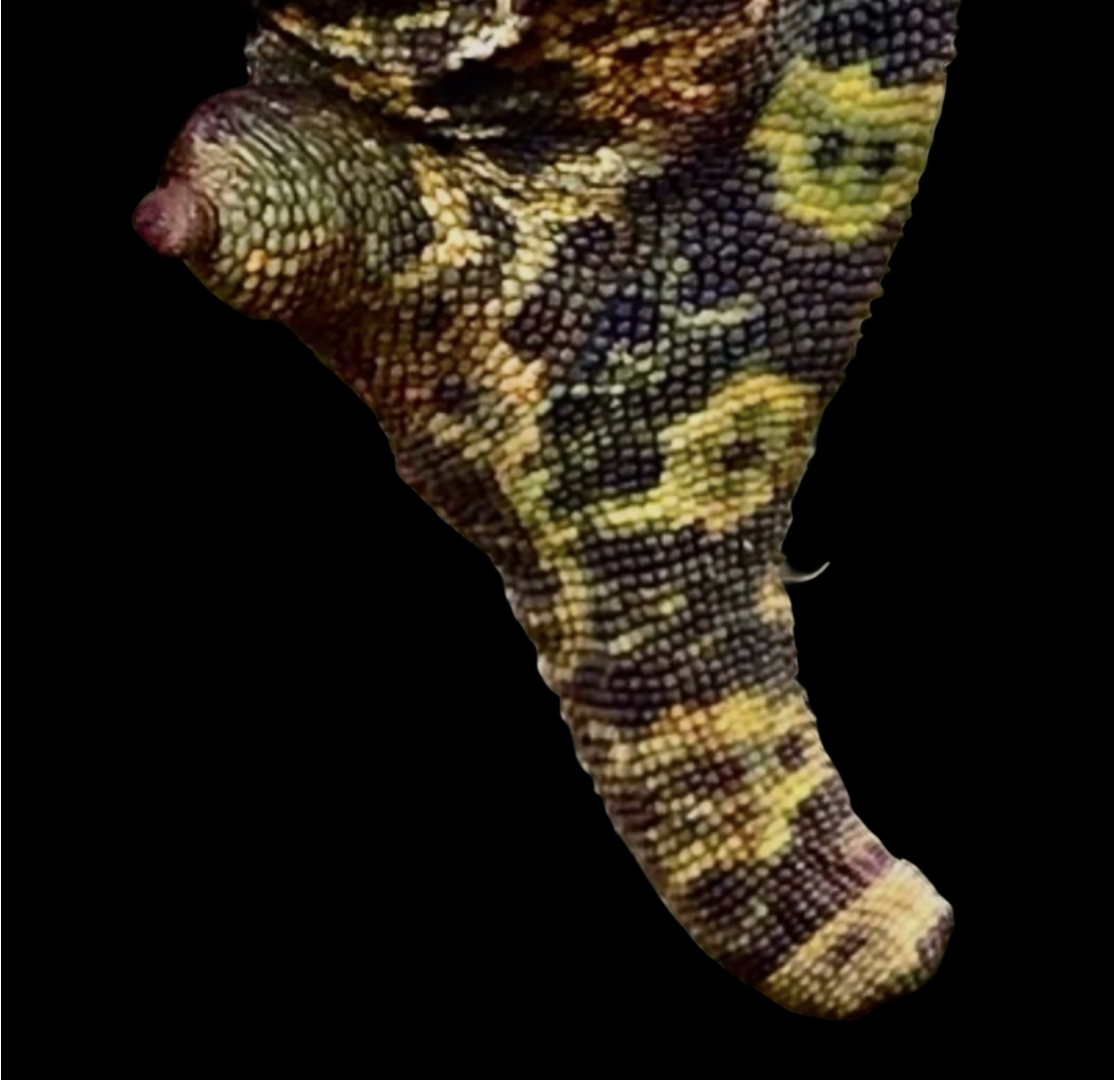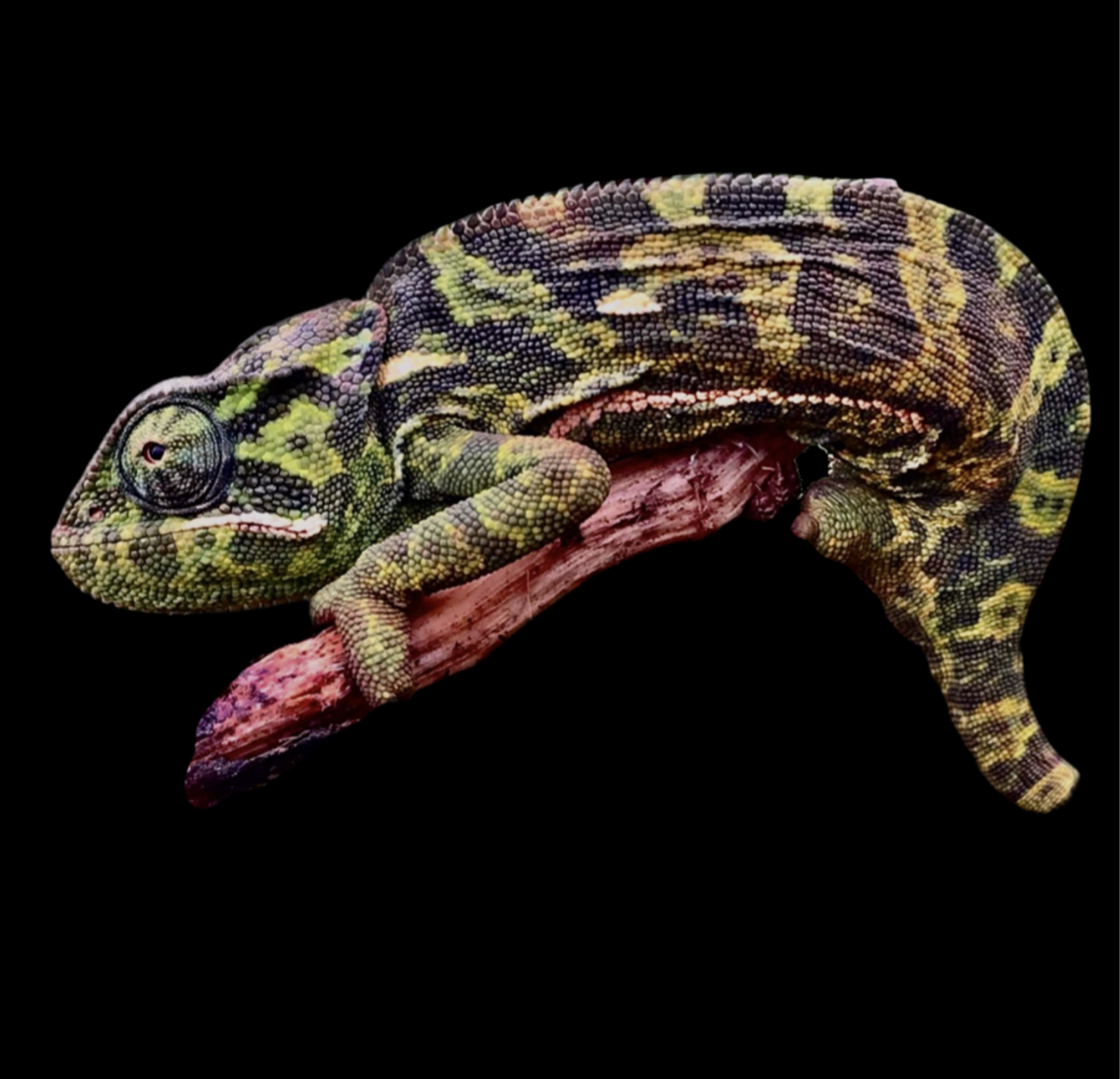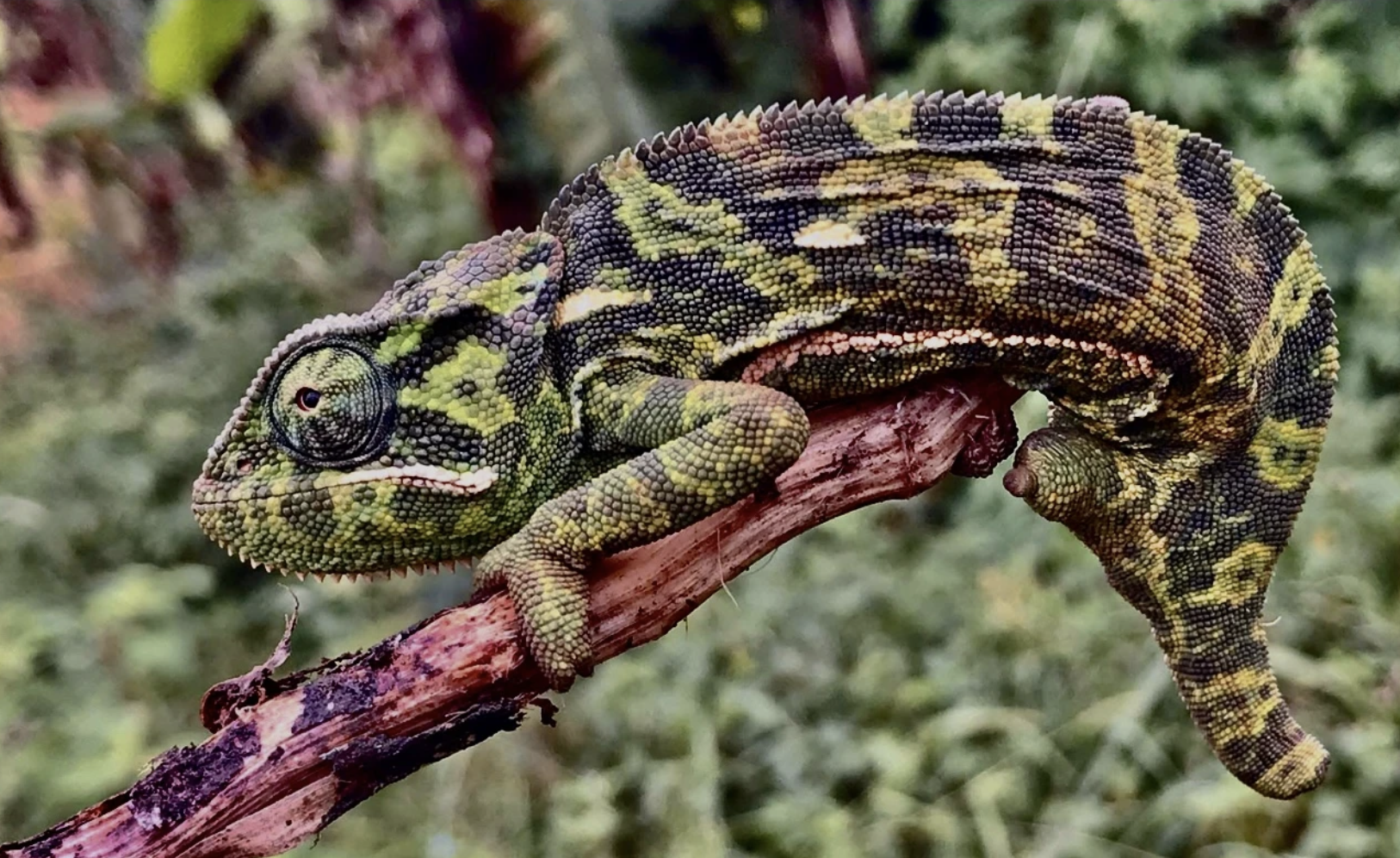The Indomitable Chameleon: A Tale of Survival Against All Odds
by Petr Nečas & Frank Priscus Shirima
Remnants of left hindleg with exposed femur and remnant of tail



Abstract
The flap-necked chameleon (Chamaeleo dilepis) is a widespread arboreal reptile native to sub-Saharan Africa. Despite its adaptability, it faces numerous ecological threats, including injury from anthropogenic sources and predation by a diverse array of vertebrates. This article provides an overview of the species' biology, summarizes known injury mechanisms and predator interactions, and presents a documented case of trauma and recovery in a wild individual from Usa River, Arusha, Tanzania.
Keywords: Chamaeleo dilepis, reptile injury, predation, Tanzania, arboreal lizards, ecological resilience
Introduction: Biology of Chamaeleo dilepis
Chamaeleo dilepis Leach, 1819, commonly known as the flap-necked chameleon, is a large, diurnal chameleon species reaching up to 35 cm in total length (Tolley 2014). It inhabits savannahs, woodlands, and coastal forests across southern and eastern Africa, including Tanzania (Reaney et al. 2012). The species is characterized by pale lateral flank patches, occipital flaps, and cryptic coloration that varies seasonally and by sex (Tilbury 2010). Although listed as Least Concern by the IUCN, C. dilepis is heavily traded internationally and subject to habitat degradation (Tolley 2014).
Injury and Trauma in Wild Chameleons
Injuries in wild C. dilepis are rarely documented but may result from predator attacks, vehicular strikes, or environmental hazards. Fire-induced mortality has been reported in southern Africa, with C. dilepis among the species affected by thermal trauma (Jordaan et al. 2019). Chameleons are physiologically sensitive to stress, and even non-lethal encounters with predators can trigger fatal shock responses (Reaney et al. 2012). Limb loss and tail amputation are particularly debilitating, given the species' reliance on grasping limbs and prehensile tails for locomotion and balance.
Predation Pressure and Known Predators
Chamaeleo dilepis faces intense and diverse predation pressure across its range in sub-Saharan Africa. As a slow-moving, visually conspicuous reptile with limited escape strategies, it is vulnerable to a wide array of predators. Predation risk is especially elevated during vulnerable life stages such as egg-laying, shedding, and nocturnal roosting (Tolley and Herrel 2013:109).
Avian Predators Birds are among the most frequent and effective predators of C. dilepis, particularly raptors and ground-foraging species with acute vision and rapid strike capabilities. Documented avian predators include:
African cuckoo hawk (Aviceda cuculoides)
Augur buzzard (Buteo augur)
Banded kestrel (Falco zoniventris)
Southern ground hornbill (Bucorvus leadbeateri)
Madagascar buzzard (Buteo brachypterus)
Ground rollers (Atelornis spp.)
Various owls and shrikes (Chameleons.info 2023; Tolley and Herrel 2013:109)
Snake Predators Arboreal snakes pose a significant threat due to their stealth and climbing ability. Notable species include:
Boomslang (Dispholidus typus)
Twig snake (Thelotornis kirtlandii)
Big-eyed snake (Mimophis mahfalensis)
Green mamba (Dendroaspis angusticeps)
Egg-eating snakes (Dasypeltis spp.) (Madcham.de 2020)
These snakes often target roosting chameleons at night or ambush them during slow movement across vegetation.
Mammalian Predators Mammals are less frequent but still impactful predators. Notable examples include:
Fossa (Cryptoprocta ferox) — a specialized chameleon hunter in Madagascar
Slender mongoose (Galerella sanguinea)
Banded mongoose (Mungos mungo)
Domestic cats (Felis catus) — especially in peri-urban environments
Lemurs and bush babies — opportunistic predation reported in forested habitats (Tolley and Herrel 2013:109; Chameleons.info 2023)
Other Threats and Opportunistic Predators Additional threats include monitor lizards, frogs, and even large invertebrates such as praying mantises and spiders, which may prey on juveniles. Human-associated threats include habitat destruction, fire, and accidental injury from agricultural machinery (Jordaan et al. 2019).
Behavioral Vulnerabilities Chameleons exhibit limited anti-predator behaviors. Their primary defense is camouflage and immobility, but this is often ineffective against visually oriented predators. Stress-induced mortality is common; even the mere presence of a predator can trigger fatal shock responses (Reaney et al. 2012:10).
Case Report: Usa River, Arusha, Tanzania (June 2025)
In June 2025, co-author Frank Priscus Shirima encountered a male C. dilepis in the Usa River area of Arusha, Tanzania. The individual had sustained severe trauma: complete loss of both hind limbs and most of its tail. The injuries were consistent with a predator attack, possibly by a bird or small mammal. Remarkably, the chameleon had survived and adapted to locomotion using only its forelimbs. The extremities showed signs of healing, and the animal exhibited no signs of dehydration or malnutrition.
This case is exceptional given the species' reliance on all four limbs and tail for arboreal movement. The observed individual had likely modified its behavior to remain within low vegetation or stable substrates. Its survival suggests a high degree of behavioral plasticity and physiological resilience.
Discussion
The documented case challenges assumptions about chameleon fragility. While C. dilepis is known to be stress-sensitive, this individual demonstrated remarkable adaptability. The absence of emaciation or dehydration implies successful foraging and hydration despite locomotor impairment. This aligns with emerging views on reptilian resilience in disturbed habitats (Reaney et al. 2012; Jordaan et al. 2019).
The case also underscores the importance of field observations in understanding species ecology. Injuries in wild reptiles are often overlooked, yet they offer insights into predator-prey dynamics, healing capacity, and behavioral adaptation.
Conclusion
The survival of a severely injured Chamaeleo dilepis in Usa River exemplifies the species' ecological resilience. Despite extensive trauma, the individual adapted to its limitations and continued to thrive. This case highlights the need for further research into reptilian injury recovery, predator interactions, and conservation strategies in anthropogenically impacted landscapes.
References
Chameleons.info. 2025. Chameleon Predators and Enemies. Retrieved from https://www.chameleons.info/en/chameleon-predators-and-enemies/
Jordaan, P. R., A. C. van der Goot, H. P. Muller, and J. C. A. Steyl. 2019. Fire-induced reptile mortality following a management burn on Lapalala Wilderness, South Africa. Herpetology Notes 12: 1173–1177.
Madcham.de. . 2020. Chameleon predators on Madagascar. Retrieved from https://www.madcham.de/en/fressfeinde-von-chamaeleons-auf-madagaskar/
Reaney, L. T., S. Yee, J. B. Losos, and M. J. Whiting. 2012. Ecology of the Flap-necked Chameleon Chamaeleo dilepis in Southern Africa. Breviora 532(1): 1–18.
Tolley, K. A., and A. Herrel. 2013. The Biology of Chameleons. Berkeley: University of California Press. 288 pp.

